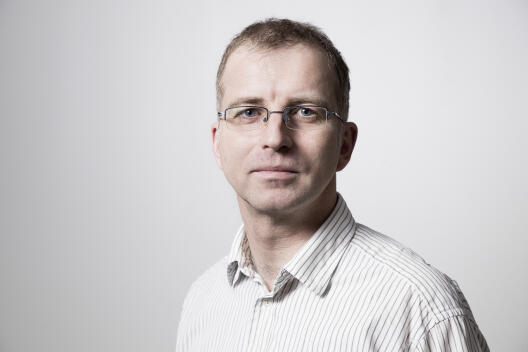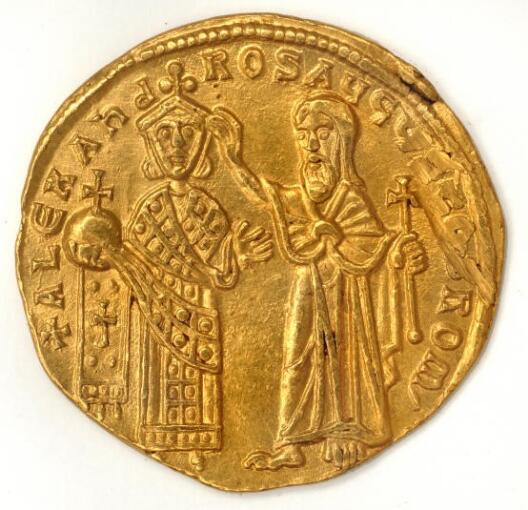A scholarly search for evidence

To what extent can a church leader also conduct political affairs in the Byzantine Empire? What is the relationship between secular and spiritual power? A coin plays an important role in helping us to answer such questions. This particular coin shows a bearded man crowning Emperor Alexander I. My scholarly search for evidence began about six years ago, when I saw the original coin at the Dumbarton Oaks Research Library and Collection in Washington DC – which, for Byzantinists like myself, is one of the most important collections of coins in the world.
As Byzantinists, we study coins in order to gain new insights into the medieval history of money, the presentation and representation of power, as well as innovations in the images used in coins. Who or what can be seen on the coin? What significance does the inscription have? With the aid of academically prepared coin catalogues, we can find comparative material that may provide further guidance in the interpretation of an image. Exchanging ideas with colleagues can also help to solve difficult questions. For example, numismatists in Paris and London have provided important information in this specific case.
As the inscription around the circumference shows, this particular gold coin, a so-called solidus, was minted on behalf of Emperor Alexander (912-913). Alexander took over power from his brother Leon VI (886-912), since an alternative succession to the throne was not possible at the time: Constantine, Leon’s son, was still a minor. There were also disputes about Constantine’s legitimate birth, as he was a product of the Emperor’s fourth marriage (which was not permitted under canon law). There is something very special about the coin: for the first time in the Byzantine history of money, a Byzantine emperor is being crowned on a coin. This would become a standard motif in the succeeding centuries: Jesus Christ, the Mother of God, or a saint crowning the ruler, or blessing him.
The image on the coin raises two complex questions: the first is to clarify the purpose and meaning of the depiction, and the second is to draw conclusions that can throw light on the distribution of power in the Byzantine Empire.

So, who is concealed behind the figure that instates Alexander as emperor? This is the question that I wanted to answer first. One tempting thesis was that it could be the patriarch of Constantinople. And indeed, on his accession to the throne, Alexander did in fact return Nicholas Mystikos to the office of patriarch, after his predecessor, Emperor Leon, had dismissed him because of the clashes over his fourth marriage and the recognition of his illegitimate son (907). This thesis found support in the fact that both figures are holding signs of power in their hands: the emperor is holding the globe as a symbol of secular power, while the figure beside him is holding a cross.
But is this interpretation correct? Although regular mention has been made since the late antiquity of the patriarch during the inauguration of the emperor, there are no pictorial representations of the act of coronation that have spiritual participation. Looking more closely at the figure next to the emperor, we can see that he is standing with his hair unfastened and his feet bare – a depiction unusual for the current spiritual leader during an official political act. The iconographic elements are reminiscent of monks and ascetics, and, when we search for examples, we encounter John the Baptist, who is figured here as the imperial benefactor; he is blessing the emperor, who acts as the representative of Christ on earth.
John the Baptist – we have therefore clarified the pictorial composition. But a further research question then arose: What is in fact the relation between secular and spiritual power in the Byzantine Empire? Were there entanglements between the two spheres of influence? Would such an image be possible? The clergy had been prevented since the late antiquity from political participation in public, even though there are cases of a local bishop taking on almost civil functions, such as organizing the defence of a city.
Despite criticism of the conflation of spiritual and secular functions, the clergy were every now and again active in the power centre of the Empire during the course of history. The patriarch Nicholas Mystikos is a unique case: after the death of Emperor Alexander (913), he took command for a good eight months of the Regency Council, which had been formed for the young Constantine, and acted like a secular ruler. Nicholas had gained experience for the political scene during his time when, before his role as a patriarch, he was Emperor Leon’s closest amanuensis (mystikos).
This example shows that it was possible in Byzantium to cross the boundaries between religion and politics, and to change sides between secular and spiritual power. We could thereby answer a significant sub-question concerning the relationship between secular and spiritual power in Byzantium.
Nicholas Mystikos would have been delighted in any case had he been immortalized on a coin. But every thesis is critically questioned in the historical sciences. Thus, exchanging ideas at international conferences allows us to examine our thoughts and ideas. Does our interpretation of the image on the coin stand up to the scrutiny of our specialist colleagues? Are there aspects that we have not considered? It is only when these questions have been answered in a differentiated way that the findings are published in academic essays and flow into the presentation of an object – in a specific case – in a museum.
The byzantibist Prof. Dr. Michael Grünbart conducts research at the University of Münster’s Cluster of Excellence “Religion and Politics”. He is the director of the project “Moses and David: Ambiguous Typologies for Patriarchs and Emperors in Byzantium”.
